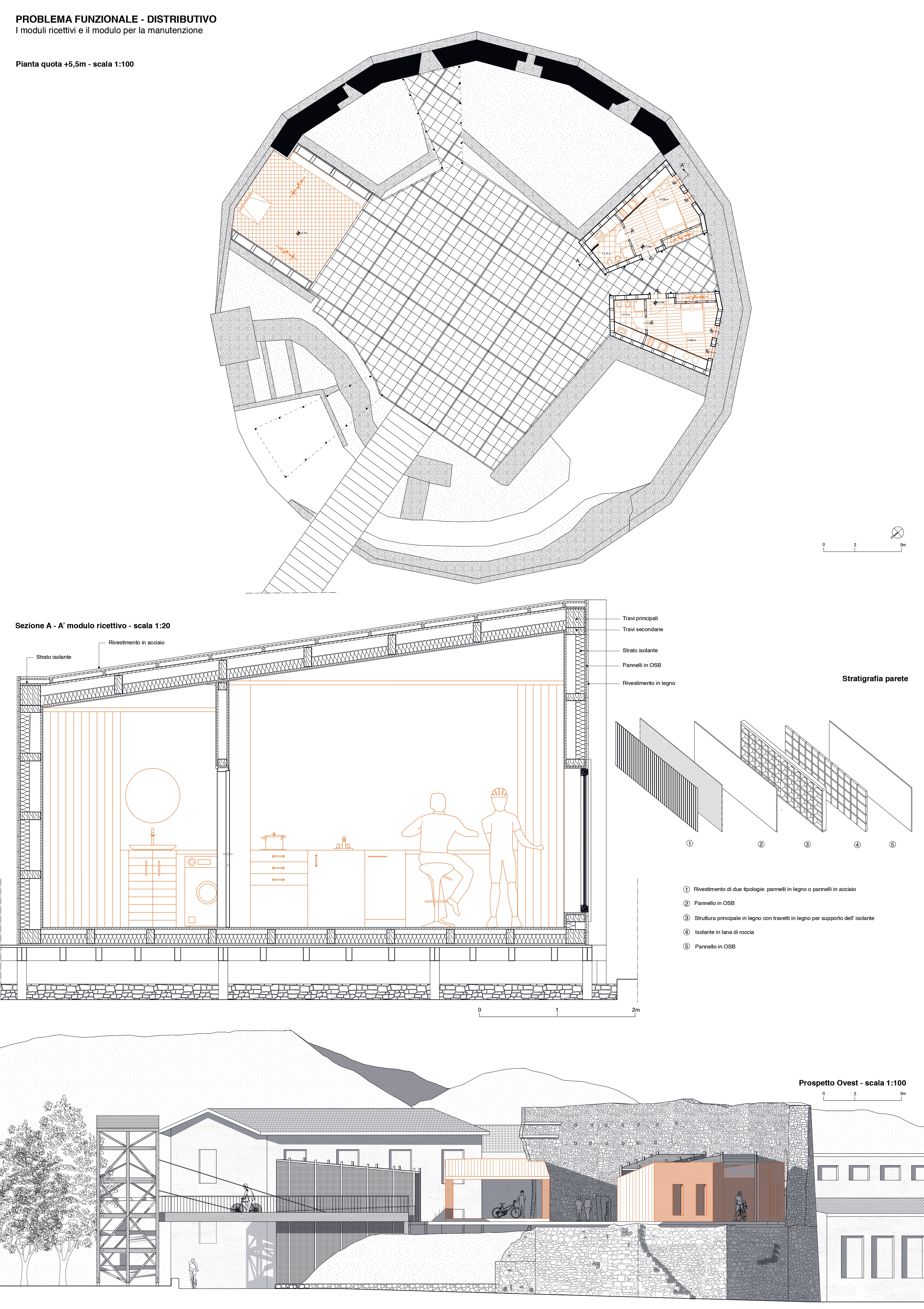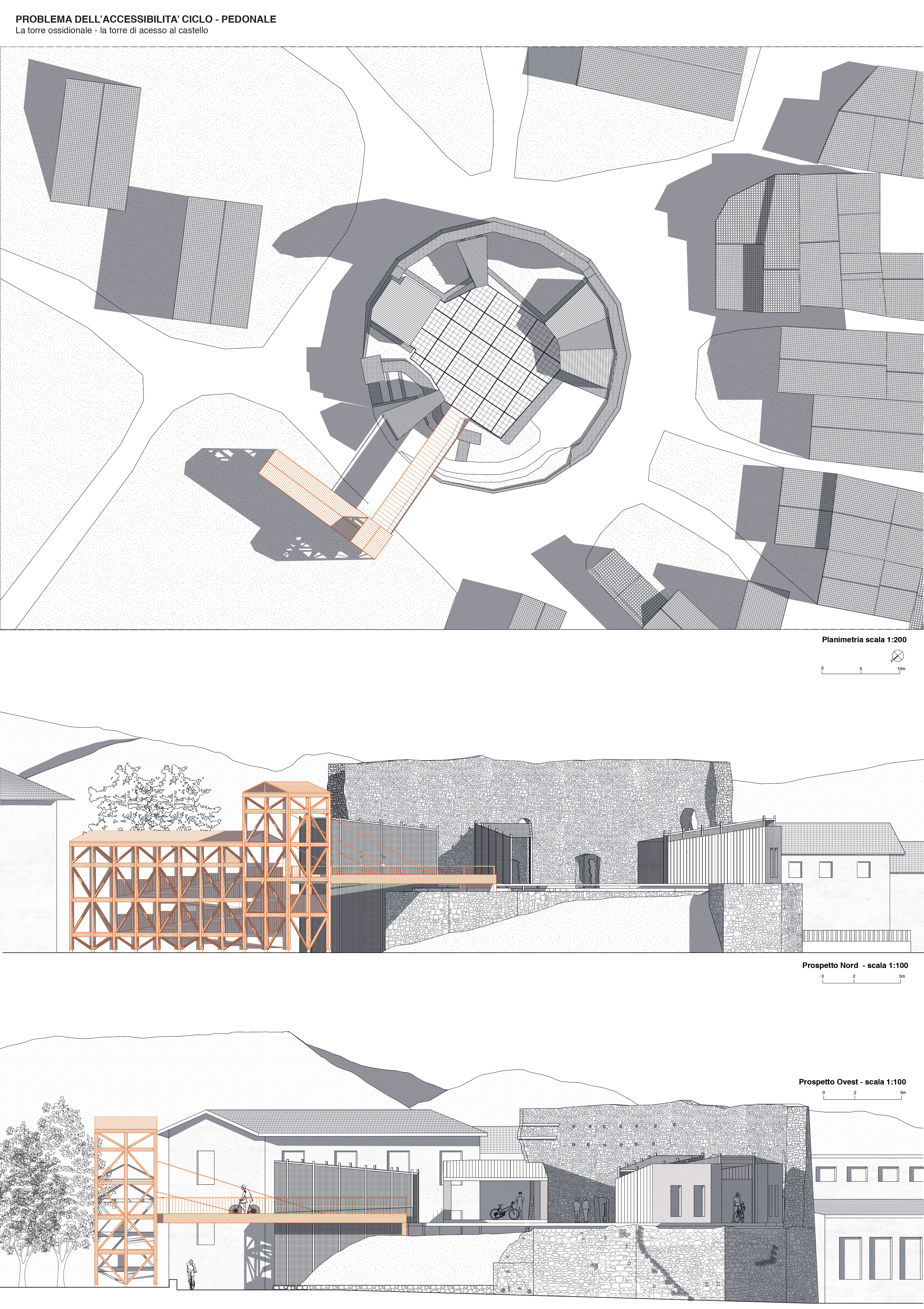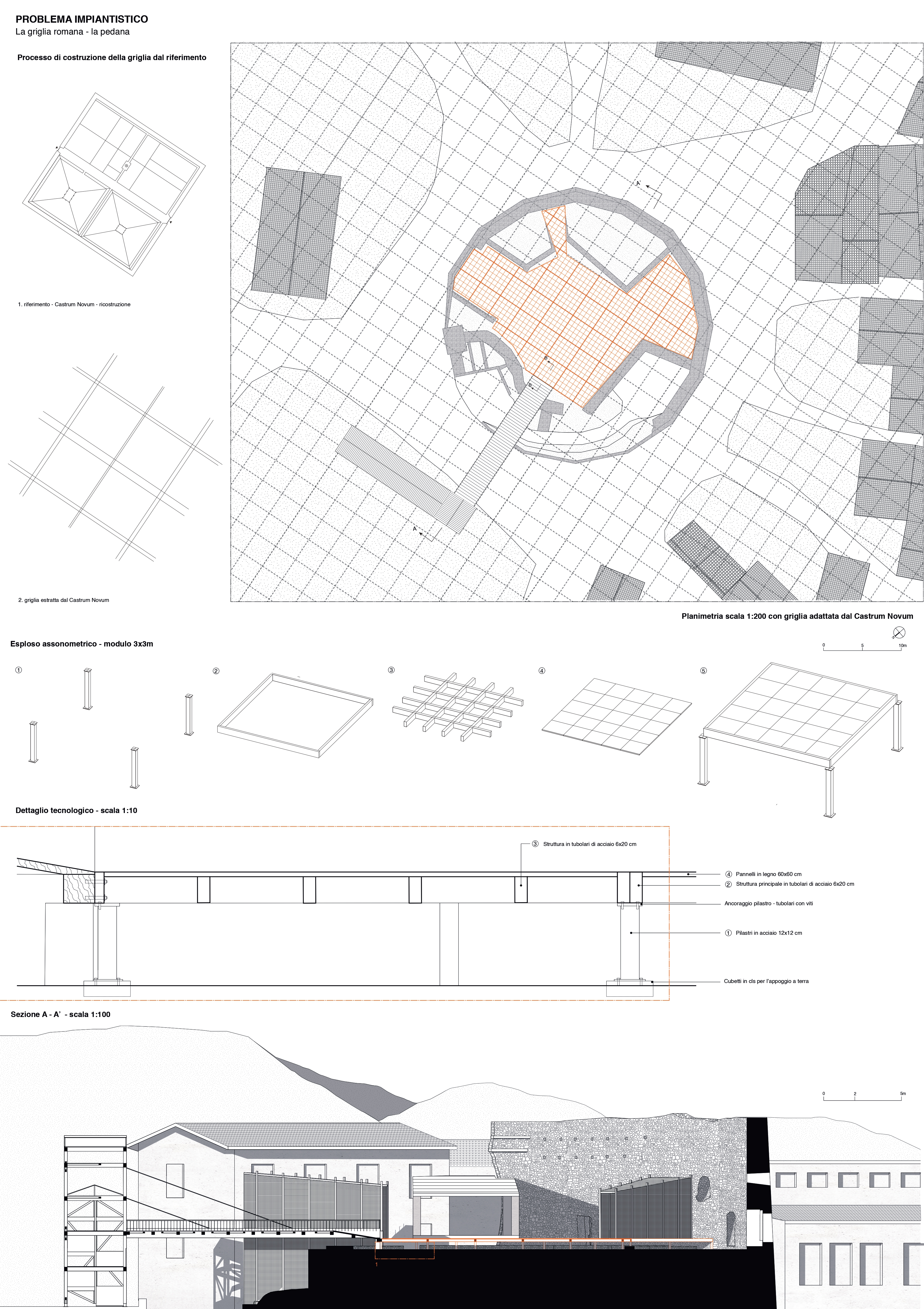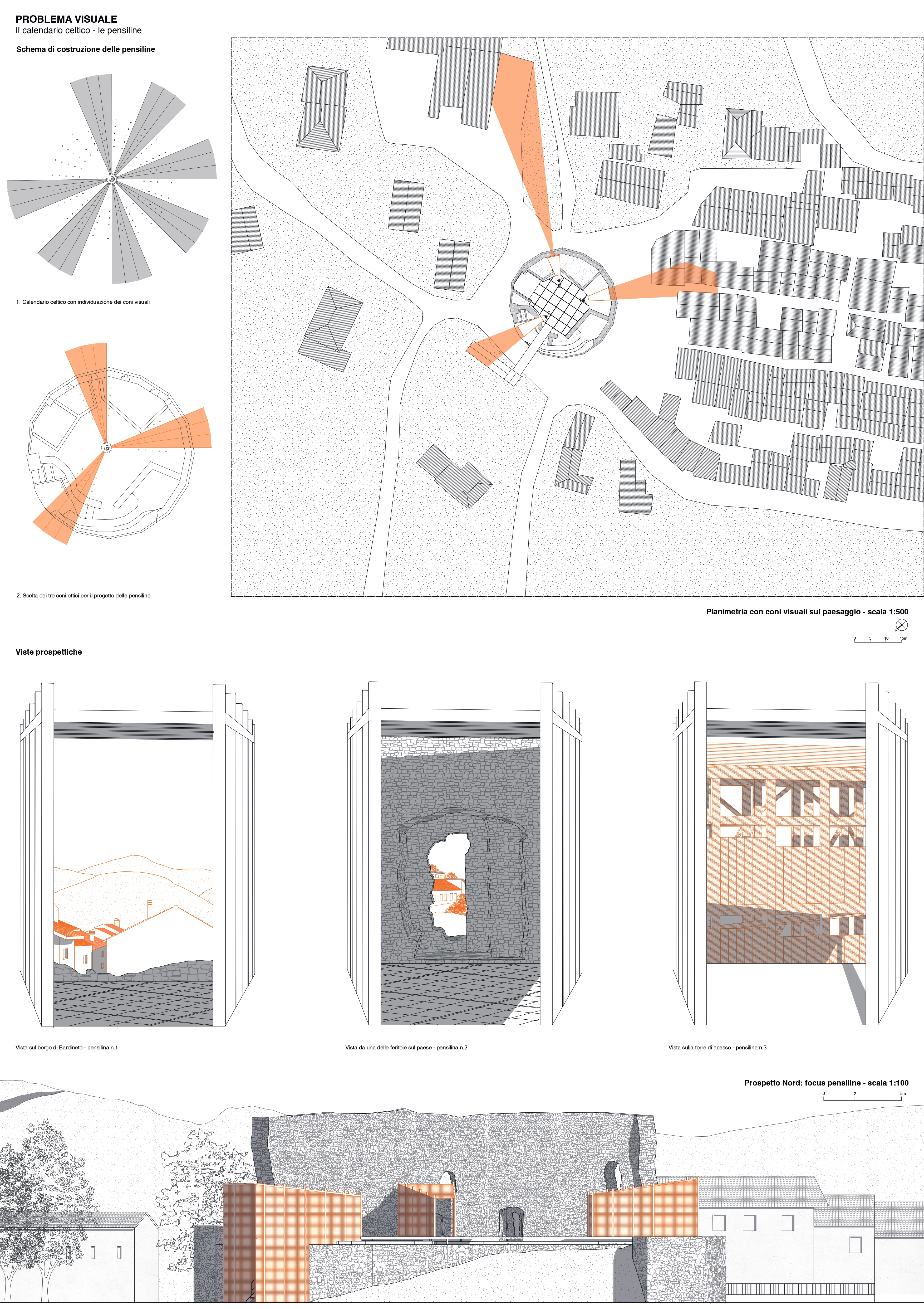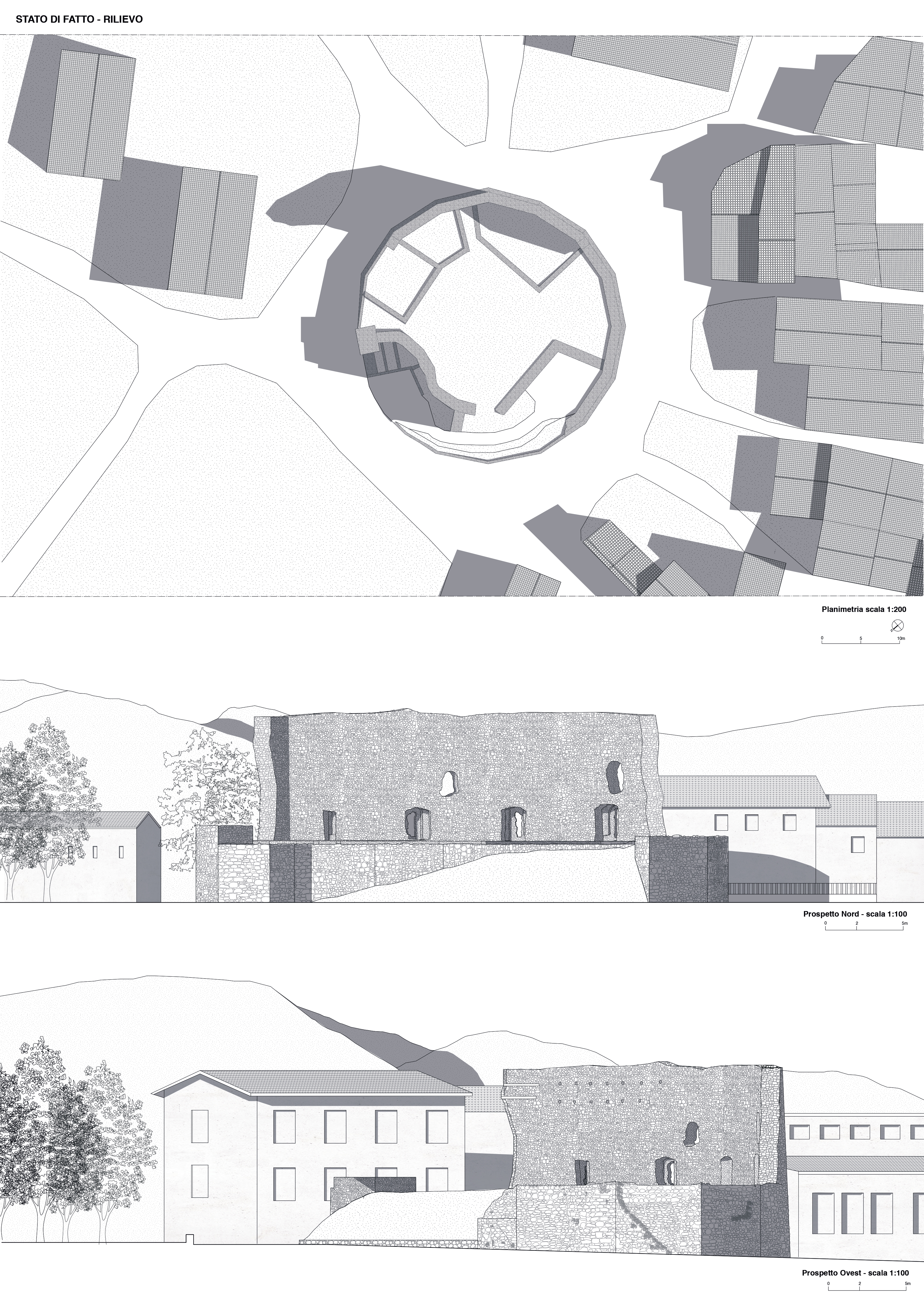Regaining a sense of belonging
FORTIFICATIONS AS CYCLE SETTELMENTS
FORTIFICATIONS AS CYCLE SETTELMENTS The Castle of Bardineto: an accomodation for cycle tourism
The project explores the connection between Alta Val Bormida's cycling network and its castles, aiming to reuse them. The work focused on the Castle of Bardineto identifies four project-related issues: accessibility to the castle, plant engineering to preserve ruins, visual integration, and functional distribution. These issues are addressed through historical analysis, revealing layers from a Celtic calendar, medieval military use, Roman urban planning, and the site’s role as a defense system.
Italy
Local
Bardineto (SV), Liguria
It addresses urban-rural linkages
It refers to other types of transformations (soft investment)
Early concept
No
No
As an individual
The main objective of the project is to explore a connection between castles in Alta Val Bormida and the cycling network of the site, in order to reuse the castles. The work is centered on the Castle of Bardineto, which represents a turning point for the territory, and it follows a specific methodology, based on the identification of project – related problems linked to the site.
Four project – related problems have been identified: the cycle – pedestrian accessibility, due to the difference in altitude between the castle and the road; the plant engineering problem arising from the need to preserve the ruins; the visual problem due to the intention to maintain visual contact with the surrounding area; the functional – distribution problem related to the arrangement of the new elements of the project. These issues have been sorted out by looking onto the history of the site, through its many layers. Following the chronological order four figures have been found: a Celtic calendar, the siege tower of medieval times, the grid that organized the city in Roman times, and in recent time the site became a defence system.
Once studied these elements, the idea for connecting the castles and the cycling network is to create a type of accommodation for cyclists, located at the site of the castle. The accommodation complex for cyclists at the Bardineto Castle includes a series of devices suitable for bicycle use, while also telling the story of the castle. Specifically, the project will consist of two housing modules, fully equipped with all the elements necessary for the cyclists’ stay, and another module dedicated to bicycle washing and maintenance. Additionally, to ensure easy access for all visitors, a ramp has been included and inside the castle, a platform has been placed to allow for smooth movement in all internal areas. The project also includes a series of canopies whose shape, derived from the Celtic calendar, creates a frame for the surrounding landscape.
Four project – related problems have been identified: the cycle – pedestrian accessibility, due to the difference in altitude between the castle and the road; the plant engineering problem arising from the need to preserve the ruins; the visual problem due to the intention to maintain visual contact with the surrounding area; the functional – distribution problem related to the arrangement of the new elements of the project. These issues have been sorted out by looking onto the history of the site, through its many layers. Following the chronological order four figures have been found: a Celtic calendar, the siege tower of medieval times, the grid that organized the city in Roman times, and in recent time the site became a defence system.
Once studied these elements, the idea for connecting the castles and the cycling network is to create a type of accommodation for cyclists, located at the site of the castle. The accommodation complex for cyclists at the Bardineto Castle includes a series of devices suitable for bicycle use, while also telling the story of the castle. Specifically, the project will consist of two housing modules, fully equipped with all the elements necessary for the cyclists’ stay, and another module dedicated to bicycle washing and maintenance. Additionally, to ensure easy access for all visitors, a ramp has been included and inside the castle, a platform has been placed to allow for smooth movement in all internal areas. The project also includes a series of canopies whose shape, derived from the Celtic calendar, creates a frame for the surrounding landscape.
Sustainable cities and communities
Good health and well - being
Reconnection with the territory
Preserve and reuse the ruins
Connect with the history of the site
The project is designed to be reversible and lightweight, which is why wood and steel are used as construction materials. Referring to the four key elements of the project: the access tower to the castle is entirely made of wood with steel joints, the platform positioned above the castle has a main steel structure with a wood panel covering, the residential modules feature a timber-framed structure, and the canopies are entirely made of steel. Additionally, the Bardineto area has an abundance of chestnut forests, which would allow the use of local wood.
The idea of combining cycling tourism with the network of castles in the Alta Val Bormida by creating a hospitality structure brings a number of advantages from different perspectives. On one hand, it allows for the development of the cycling network in the area, which currently suffers from significant discontinuity, with the potential to increase bicycle use and connect the region with neighboring areas, benefiting those who travel by bike. Developing a hospitality structure near the castle, in addition to its aesthetic appeal appreciated by visitors, also benefits the castle itself by giving it a new lease on life, helping to counteract abandonment and decay. Furthermore, by creating a series of hospitality structures near the castles throughout the Alta Val Bormida, a network of rest stops could be established, allowing cyclists to visit the castles and bringing life back not only to the castle of Bardineto but to all those in the area.
Accessibility is one of the four key challenges of the initial project. All the devices designed in this context ensure accessibility for everyone, including cyclists. The current elevation difference between the road and the castle's ground level led to the creation of a ramp that respects both the surrounding landscape and the castle's history. A structure was therefore designed to resemble medieval siege towers, housing the ramps that lead up to the castle level. Above the walking surface, a platform was designed to allow smooth movement within the castle courtyard and to connect to the other two elements: the modules and the canopies, both easily accessible and on the same level as the platform. The residential modules, though modest in size, feature a spacious interior.
The project idea has been discussed locally with members of the municipality, cyclists, and cycle tourists to gather opinions from potential users of the hospitality structure, as well as from local residents. Regarding the cycle tourists, positive feedback was received, as there is currently a lack of equipped rest stops for those traveling by bike in the area, as well as for any necessary maintenance. The idea of creating these distributed structures across the territory also represents an advantage, allowing for more comprehensive trip planning. From the perspective of the local residents, the main consequence that could arise is an increase in tourists and visitors, which would certainly benefit the local economy, which is currently little known and seldom visited.
The project involved the technician from the municipality of Bardineto, who provided several indications, especially regarding the cycling network in the area, its current state, and potential future projects, although none exist at present. Within the municipality, efforts were made to find and discuss any documents or photographs that could testify to the original layout of the castle and its use, which is important for reconstructing its history. Also, regarding the history, which is crucial for the work of rebuilding a sense of belonging to the territory, a conversation with Professor Giannino Balbis, a historian who wrote a book on Bardineto and extensively studied the town and the castle, was essential.
The project began with a regional analysis of the cycling network in Liguria and Piedmont, then moved to the territorial level of the Val Bormida, also investigating the current situation of the castles in the area. During this phase, cartographic knowledge was essential to read and extract information from existing maps. Moving to the local level and studying the castle of Bardineto, the focus shifted to recovery and repurposing. With the help of cartographic studies and the history of the area, a solution was found that could give new life to the castle and potentially to all the castles in the valley.
By combining the theme of cycling with the network of castles, it was possible to find an element that allows the defensive structures to be reconnected, as they often were when originally built as part of a defensive network. In Italy, only a few regions have created initiatives to raise awareness of their castle networks and enhance them, usually with dedicated websites that display the routes and tell their stories. This project stands out in this sense because it aims to connect the castles not only ideally but also physically, through the cycling network.
The starting point was a thorough study of the area and the castles, from both a territorial and social perspective, to understand how to connect the castles with the cycling network and whether this connection could be the solution. The design of the hospitality structure then follows a specific methodology, based on identifying project-related issues linked to the site or the subject of intervention. These problems are examined and resolved through the choice of representations and figures that make up the project. After conducting the necessary site studies, four design issues emerged: cycle-pedestrian accessibility, related to the elevation difference between the castle and the road; the technical problem, due to the need to find a solution for placing systems without damaging the ruins; the visual problem, arising from the desire to maintain visual contact with the main landmarks in the area; and the functional-distributive problem, concerning the layout and function of the new elements. These themes were addressed by exploring the memory of the castle, through its many layers, for figures to inform the project design. Following the chronological order, historical research identified the Celtic calendar located where the castle now stands, the medieval siege tower used to surpass the height of defensive walls, the Roman grid that organized the layout of Roman military camps, and the castle's floor plan with the arrangement of its internal rooms. These elements were used as references for the design of the project.
The methodology used in designing the hospitality elements is very versatile, as it takes into account the history of the project site. In fact, starting from the history of the castle, it is possible to create devices for cycle tourists based on the characteristics of the castle itself as well as its surroundings, considering its history and original layout if necessary. In this sense, it is possible to extend this project, initially developed for the castle of Bardineto, to other castles in the Upper Val Bormida, adapting it to local needs and for cycle tourists. This type of structure is also adaptable to other regions that have a network of castles intersected by cycling paths or even hiking trails. The project is, in fact, versatile from this point of view as well, because the concept of a network can also be applied to other types of users, such as hikers or bikers.
The main global challenge addressed in this project is the promotion of bicycle use, which brings a series of benefits in terms of reducing emissions and improving health for urban residents. The primary issue of the territory where the project is developed is the lack of spaces to allow for proper design of cycling paths, along with the orography typical of Liguria, which makes it even more challenging for everyone to use the cycling network. Therefore, the first objective of this work is the improvement and expansion of cycling paths in the area, also adding services and rest points. In terms of sustainability, the focus has been on minimizing environmental impact by using materials such as wood, which is locally available.
With the collaboration of the supervisors of this Master's Thesis, the idea is to present this concept locally to organizations that focus on cycling and are active in implementing and improving the Ligurian cycling network. If applicable, further technical development of the project is also anticipated.

